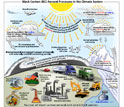News Release 13-067
Cutting Specific Atmospheric Pollutants Would Slow Sea Level Rise
Decreasing emissions of black carbon, methane and other pollutants makes a difference

Black carbon, a short-lived pollutant (shown in purple), shrouds the globe.
April 14, 2013
This material is available primarily for archival purposes. Telephone numbers or other contact information may be out of date; please see current contact information at media contacts.
With coastal areas bracing for rising sea levels, new research indicates that cutting emissions of certain pollutants can greatly slow sea level rise this century.
Scientists found that reductions in four pollutants that cycle comparatively quickly through the atmosphere could temporarily forestall the rate of sea level rise by roughly 25 to 50 percent.
The researchers focused on emissions of four heat-trapping pollutants: methane, tropospheric ozone, hydrofluorocarbons and black carbon.
These gases and particles last anywhere from a week to a decade in the atmosphere and can influence climate more quickly than carbon dioxide, which persists in the atmosphere for centuries.
"To avoid potentially dangerous sea level rise, we could cut emissions of short-lived pollutants even if we cannot immediately cut carbon dioxide emissions," says Aixue Hu of the National Center for Atmospheric Research (NCAR) in Boulder, Colo., first author of a paper published today in the journal Nature Climate Change.
"Society can significantly reduce the threat to coastal cities if it moves quickly on a handful of pollutants."
The research was funded by the National Science Foundation (NSF) and the U.S. Department of Energy.
"Sea level rise and its consequences present enormous challenges to modern society," says Anjuli Bamzai, program director in NSF's Division of Atmospheric and Geospace Sciences, which supported the research.
"This study looks at projections of global sea level rise, unraveling the effects of mitigating short-lived greenhouse gases such as methane, tropospheric ozone, hydrofluorocarbons and black carbon, as well as long-lived greenhouse gases like carbon dioxide," says Bamzai.
It is still not too late, "by stabilizing carbon dioxide concentrations in the atmosphere and reducing emissions of shorter-lived pollutants, to lower the rate of warming and reduce sea level rise by 30 percent," says atmospheric scientist Veerabhadran Ramanathan of the Scripps Institution of Oceanography (SIO) in San Diego, a co-author of the paper. Ramanathan initiated and helped oversee the study.
"The large role of the shorter-lived pollutants is encouraging since technologies are available to drastically cut their emissions," says Ramanathan.
The potential effects of rising oceans on populated areas are of great concern, he says.
Many of the world's major cities, such as New York, Miami, Amsterdam, Mumbai, and Tokyo, are located in low-lying areas along coasts.
As glaciers and ice sheets melt, and warming oceans expand, sea levels have been rising by an average of about 3 millimeters annually in recent years (just over one-tenth of an inch).
If temperatures continue to warm, sea levels are projected to rise between 18 and 200 centimeters (between 7 inches and 6 feet) this century, according to reports by the Intergovernmental Panel on Climate Change and the U.S. National Research Council.
Such an increase could submerge coastal communities, especially when storm surges hit.
Previous research by Ramanathan and Yangyang Xu of SIO, a co-author of the paper, showed that a sharp reduction in emissions of shorter-lived pollutants beginning in 2015 could offset warming temperatures by up to 50 percent by 2050.
Applying those emission reductions to sea level rise, the researchers found that the cuts could dramatically slow rising sea levels.
The results showed that total sea level rise would be reduced by an estimated 22 to 42 percent by 2100, depending on the extent to which emissions were cut.
However, the study also found that delaying emissions cuts until 2040 would reduce the beneficial effect on year-2100 sea level rise by about a third.
If society were able to substantially reduce both emissions of carbon dioxide as well as the four other pollutants, total sea level rise would be lessened by at least 30 percent by 2100, the researchers conclude.
"We still have some control over the amount of sea level rise we are facing," Hu says.
Another paper co-author, Claudia Tebaldi of Climate Central, adds: "Without diminishing the importance of reducing carbon dioxide emissions in the long-term, this study shows that more immediate gains from shorter-lived pollutants are substantial.
"Cutting emissions of those gases could give coastal communities more time to prepare for rising sea levels," says Tebaldi. "As we have seen recently, storm surges in populated regions of the East Coast show the importance of making such preparations and cutting greenhouse gases."
To conduct the study, Hu and colleagues turned to the NCAR-based Community Climate System Model, as well as a second computer model that simulates climate, carbon and geochemistry.
They also drew on estimates of future emissions of heat-trapping gases under various social and economic scenarios and on computer models of melting ice and sea level rise.
The study assumes that society could reduce emissions of the four gases and particles by 30-60 percent over the next several decades.
That is the steepest reduction believed achievable by economists who have studied the issue at Austria's International Institute for Applied Systems Analysis, one of the world's leading research centers into the effects of economic activity on climate change.
"It must be remembered that carbon dioxide is still the most important factor in sea level rise over the long-term," says NCAR scientist Warren Washington, a paper co-author. "But we can make a real difference in the next several decades by reducing other emissions."
-NSF-
-
The path to black carbon: where it comes from, where it goes.
Credit and Larger Version -
Image showing thick haze and smoke along the Ganges Basin in northern India.
Credit and Larger Version -
Controlled burns release huge amounts of sooty black carbon into the atmosphere.
Credit and Larger Version -
Soot in exhaust spews out black carbon.
Credit and Larger Version -
Black carbon enters the atmosphere, then returns to land and sea.
Credit and Larger Version
Media Contacts
Cheryl Dybas, NSF, (703) 292-7734, email: cdybas@nsf.gov
David Hosansky, NCAR, (303) 497-8611, email: hosansky@ucar.edu
Robert Monroe, SIO, (858) 534-3624, email: rmonroe@ucsd.edu
The U.S. National Science Foundation propels the nation forward by advancing fundamental research in all fields of science and engineering. NSF supports research and people by providing facilities, instruments and funding to support their ingenuity and sustain the U.S. as a global leader in research and innovation. With a fiscal year 2023 budget of $9.5 billion, NSF funds reach all 50 states through grants to nearly 2,000 colleges, universities and institutions. Each year, NSF receives more than 40,000 competitive proposals and makes about 11,000 new awards. Those awards include support for cooperative research with industry, Arctic and Antarctic research and operations, and U.S. participation in international scientific efforts.
Connect with us online
NSF website: nsf.gov
NSF News: nsf.gov/news
For News Media: nsf.gov/news/newsroom
Statistics: nsf.gov/statistics/
Awards database: nsf.gov/awardsearch/
Follow us on social
Twitter: twitter.com/NSF
Facebook: facebook.com/US.NSF
Instagram: instagram.com/nsfgov







